NCERT Solutions For Class 4 Maths Chapter 9 - Halves And Quarters
Halves and Quarters deals with the concept of fraction. This chapter have exercises on half, one fourth, and three-fourth of a whole. Simple fractions. The solutions for Math-Magic Chapter-9 have been created and verified by our experienced subject matter experts, according to the CBSE syllabus and guidelines of NCERT. For practice, our subject matter experts have created very interactive, activity-based, and Image-based worksheets on these topics to enhance learning.
Download PDF For NCERT Solutions for Maths Halves And Quarters
The NCERT Solutions For Class 4 Maths Chapter 9 - Halves And Quarters are tailored to help the students master the concepts that are key to success in their classrooms. The solutions given in the PDF are developed by experts and correlate with the CBSE syllabus of 2023-2024. These solutions provide thorough explanations with a step-by-step approach to solving problems. Students can easily get a hold of the subject and learn the basics with a deeper understanding. Additionally, they can practice better, be confident, and perform well in their examinations with the support of this PDF.
Download PDF
Access Answers to NCERT Solutions For Class 4 Maths Chapter 9 - Halves And Quarters
Students can access the NCERT Solutions For Class 4 Maths Chapter 9 - Halves And Quarters. Curated by experts according to the CBSE syllabus for 2023–2024, these step-by-step solutions make Maths much easier to understand and learn for the students. These solutions can be used in practice by students to attain skills in solving problems, reinforce important learning objectives, and be well-prepared for tests.
Halves And Quarters
Rani got a chocolate. She divided it equally and gave half to her friend Reena. Circle the portion that Reena got.

Observe the picture of the chocolate and divide it into two equal halves.
The correct answer is:
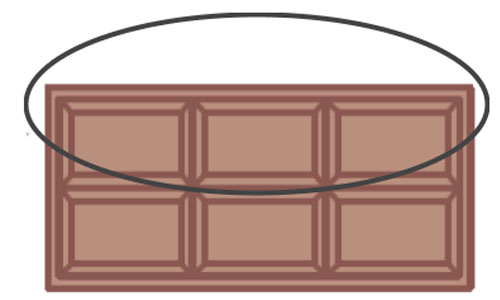
Take a piece of paper. Cut the sheet into two equal triangles so that each triangle is equal to half of the sheet. Shade the two triangles with different colours.
Draw different shapes using these triangles. One such shape is shown here.
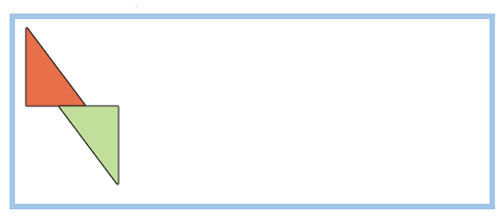
Do it by yourself. Answers may vary. Some shapes are shown below:
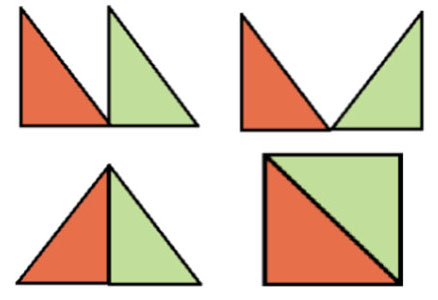
In how many different ways can you cut a rectangle into half? Draw 5 different ways:
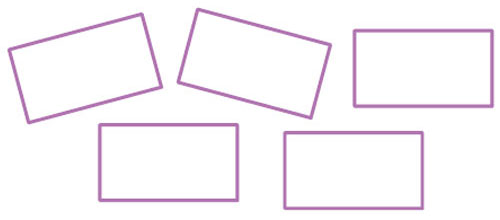
There are so many different ways to cut a rectangle into half. Answers may vary from student to student. A sample answer is:
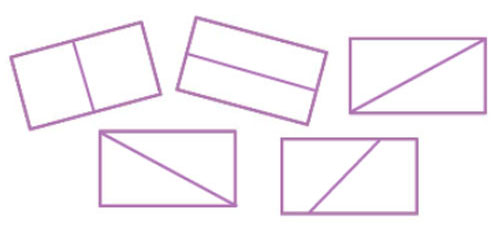
Out of 4 parts Rajni will get _____ parts, which is equal to half of the cake. So, she can write it as ½
Out of 4 parts Rajni will get 2 parts, which is equal to ½ of the cake. So, Rajni can write it as 2/4 or 1/2
Rajni’s father brought a cake. She divided the cake into 4 equal parts—for herself, her brother Raju, her father, and her mother. Colour each share with different colours.
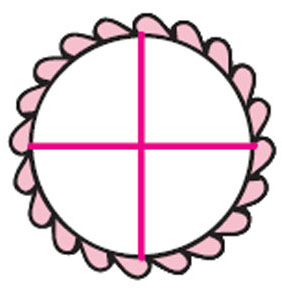
Use the colour of your choice to colour each share with different colours. Answers may vary. A sample answer is:
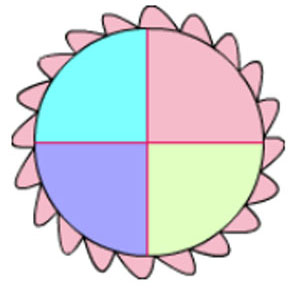
b) Colour that part of the shape which is written below.
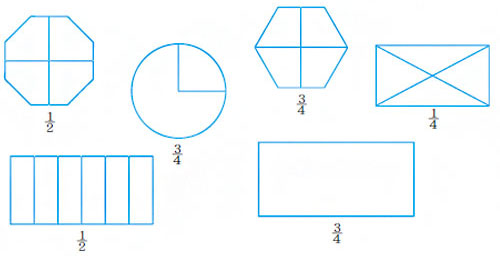
The correct answer is:
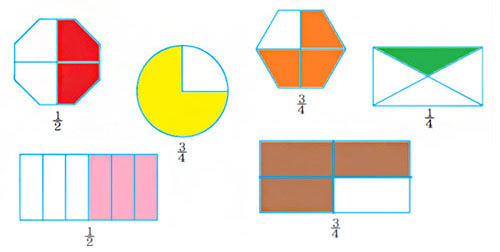
Mother gave her share of cake to Rajni. Now colour the total part that Rajni will get
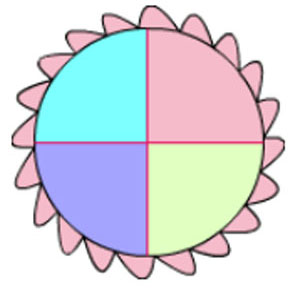
Rajni got 1 of the 4 parts of the cake as her share. Her mother gave her 1 of the 4 parts. Therefore, she got 2 of the 4 parts of the cake.
Shade any 2 parts to show Rajni’s share. A sample answer is:
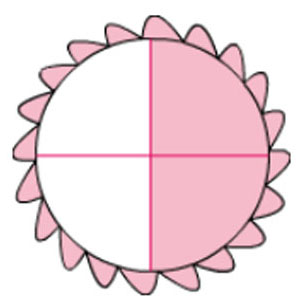
c) Cut in half
Draw a line which divides these shapes into half.
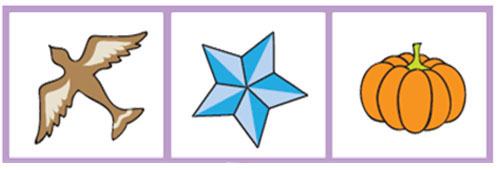
Draw a line in each of the given shapes such that it divides the shape into two equal halves. The correct answer is:
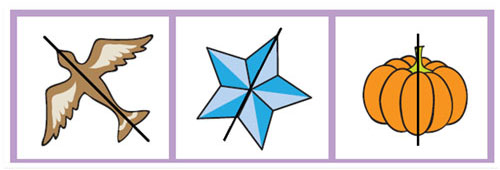
This bottle is full of milk and it holds one litre. The milk is put into 4 other bottles so that each bottle has 1 4 litre of milk.
Shade the bottles to show the level of milk in each.
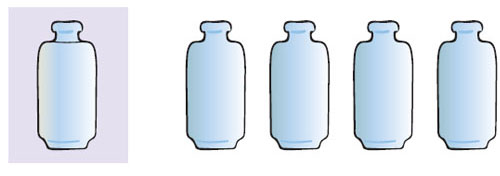
Each bottle has 1/4 litre of milk. Divide the bottles into 4 equal parts and shade only part to show the level of milk in each bottle.
The correct answer is:
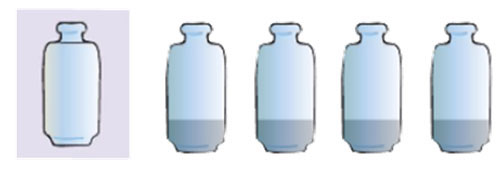
Colour the share Raju got.
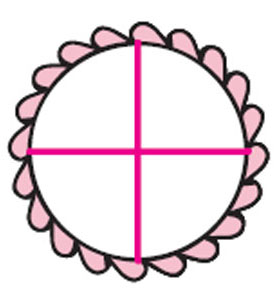
Raju got 1 of the 4 parts of the cake as his share. Shade any one part to colour the share of Raju. A sample answer is:
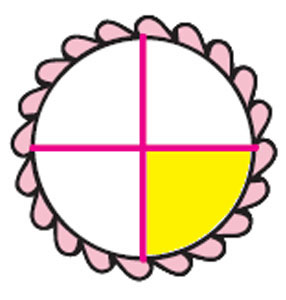
Using a Price List
a) How much does 1/2 kg of tomatoes cost?
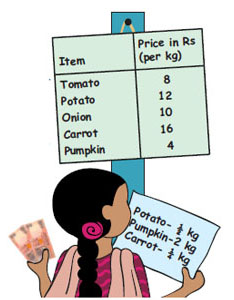
1 kg of tomatoes is for Rs 8. Divide 8 by 2 to get the price of 1/2 kg of tomatoes.
8 ÷ 2 = 4
Therefore, the cost of 1/2 kg of tomatoes is Rs 4.
How much of the cake do Rajni and Raju together get? Colour their total share.
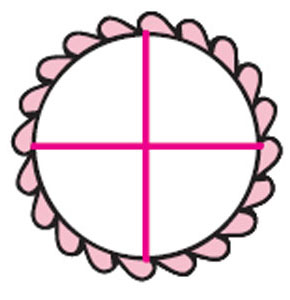
Rajni got 2 out of 4 parts and Raju got 1 out of 4 parts. Therefore, Rajni and Raju together got 2 + 1 = 3 out of 4 parts of the cake, that is, 3/4 of the total cake. Shade any 3 parts to colour the total share of Rajni and Raju. A sample answer is:
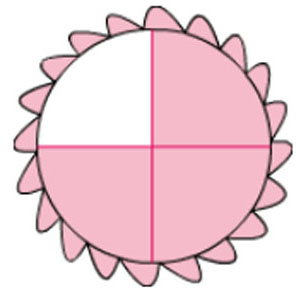
f) Match the coloured part as shown.
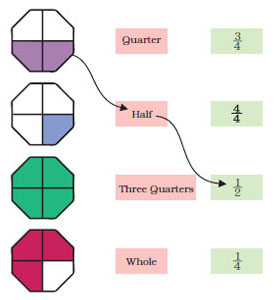
The correct answer is:
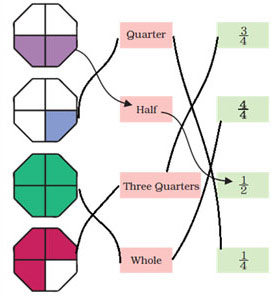
g) Make the other half.
1/2 of the picture is drawn here. Can you complete the picture by drawing the other half?

Draw the same shape on the opposite side of each figure to complete the other half.
The correct answer is:

a) Draw the weights in the empty pan.
Answers may vary. A sample answer is:

If the cats ask you to divide the chapati equally, how will you divide it?
The chapati is round in shape. Fold it from the middle,and you will get the creased line. Tear it from the creased line to divide it into two equal parts.
If two more cats come for food how will you divide one chapati equally between four cats?
You can first fold the chapati into two halves and then again fold it into another two halves. You will get a creased line, tear it from the creased lines to divide it into 4 equal parts.
How many pieces of chocolate are there?
AIt is observed from the given picture of chocolate that there are 6 pieces of chocolate.
How many pieces were left with Rani?
There are 6 pieces of chocolate. Rani gave 3 pieces to her friend. Subtract 3 from 6 to get the number of pieces left with Rani.
6 – 3 = 3
Therefore, 3 pieces were left.
Can you check if they are equal?
Do it by yourself and verify.
Can you check if they are equal?
Do it by yourself and verify.
How much does each get?
The cake is divided into 4 equal parts and everyone has received one part. Therefore, each of them gets one fourth of the cake.
One day he wants to eat pumpkin halwa (sweet dish). He tries to buy a big pumpkin with only Rs10. He asks the first pumpkin seller the price of a big pumpkin.
First pumpkin seller— 1/4 of this pumpkin is for Rs 10. This full pumpkin will cost Rs _____?
The cost of 1 out 4 parts of pumpkin is Rs 10. Multiply 10 by 4 to get the cost of the full pumpkin.
10 × 4 = 40
Therefore, full pumpkin will cost Rs 40.
Kundu—How much of this pumpkin will I get for Rs10? Second pumpkin seller—Half.
This full pumpkin will cost Rs ______
The cost of 2 out of 4 parts of the pumpkin is Rs 10. Multiply 10 by 2 to get the cost of full pumpkin.
10 × 2 = 20
Therefore, the full pumpkin will cost Rs 40
b) Which costs more – 1/2 kg of onions or 1/4 kg of carrots.
Step 1: 1 kg of onions is for Rs 10. Divide 10 by 2 to get the cost of 1/2kg of onions. 10 ÷ 2 = 5
Therefore, the cost of 1/2 kg of onions is Rs 5.
Step 2: 1 kg of carrots is for Rs 16. Divide 16 by 4 to get the cost of 1 4 kg of carrots.
16 ÷ 4 = 4
Therefore, the cost of 1/4 kg of carrots is Rs 4.
Hence, the cost of 1/2 kg of onions is more than the cost of 1/4 kg of carrots.
c) What is the price of 3/4 kg of potatoes?
Step 1: 1 kg of potatoes is for Rs 12. Divide 12 by 4 to get the cost of 1/4 kg of potatoes.
12 ÷ 4 = 3
Step 2: Multiply 3 by 3 to get the cost of 3/4 kg of potatoes.
3 × 3 = 9 Therefore, the cost of 3/4 kg of potatoes is Rs 9.
e) Make two questions yourself from the price list.
1.
2.
Use the given price list and frame two questions. Answers may vary. A sample answer is:
1. Find the cost of 5 kg of potatoes.
2. Find the cost of 2 kg of pumpkin.
Using your metre scale, cut a string of one metre.
On this string mark the length 1/2 meter,1/4 meter and 3/4 meter.
Using your string draw a line of length 1/2 metre on the floor. How many centimetres long is the line? ___________
Perform the activity by yourself.
The relation between metre and centimetre is 1 m = 100 cm. Therefore, half of a metre is equal to 50 cm. Hence, the line is 50 cm long.
So, 1/2metre = _____ cm
We know that, 1 metre = 100 centimetre. Therefore, divide 100 by 2 to convert 1/2 metre to centimetre.
100 ÷ 2 = 50
1/4 metre = _____ cm
Since 1 metre = 100 centimetre, divide 100 by 4 to convert 1/4 metre to centimetre.
100 ÷ 4 = 25
So, 1/4 metre = 25 cm.
3/4 metre = _____ cm
Step 1: Since 1 metre = 100 centimetre, multiply 100 by 3 to convert 3 metres to centimetres.
100 × 3 = 300
Step 2: Divide 300 by 4 to convert 3/4 metre to centimetre.
300 ÷ 4 = 75
Therefore, 3/4 metre = 75 cm
Can you see that when we add 1/2 and 1/4 we get 3/4 ?
Since 1/2 metre = 50 cm, 1/4 metre = 25 cm, and 3/4 metre = 75 cm,
Add 50 and 25.
50 + 25 = 75
Thus, the sum of 1/2 and 1/4 is 3/4
How many millilitres of milk does each bottle have?
We know that, 1000 millilitres = 1 litre. Each bottle contains 1/4 litre of milk. Divide 1000 by 4 to convert 1/4 liter to milliliter.
1000 ÷ 4 = 250
Thus, each bottle has 250 millilitres of milk.
How many millilitres of milk does each bottle hold?
Step 1: We know that, 1 litre = 1000 millilitre. Therefore, multiply 1000 by 3 to convert 3 litres to millilitres.
1000 × 3 = 3000
Step 2: Divide 3000 by 4 to convert 3/4 litres to millilitres.
3000 ÷ 4 = 750
Thus, first bottle holds 750 millilitres of milk.
Step 3: Divide 1000 by 4 to convert 1/4 litres to millilitres.
1000 ÷ 4 = 250
Thus, the second bottle holds 250 millilitres of milk.
There are 60 mangoes. 1/2 of them are ripe. How many mangoes are ripe?
The total number of mangoes are 60. Out of which half of the mangoes are ripe.
Divide 60 by 2 to get the number of ripe mangoes.
60 ÷ 2 = 30
Therefore, 30 mangoes are ripe.
There are 32 children. 1/2 of them are girls. How many children are boys?
The total number of children are 32. Out of which half of the children are girls and the other half are boys.
Divide 32 by 2 to get the number of boys.
32 ÷ 2 = 16
Therefore, there are 16 boys.
There are 20 stars. A quarter of them are red. How many stars are red?
How many are not red?
Step 1: The total number of stars are 20. 1/4 of them are red. Divide 20 by 4 to get the number of red stars.
20 ÷ 4 = 5
Therefore, there are 5 red stars.
Step 2: Subtract 5 from 20 to get number of stars that are not red.
20 – 5 = 15
Therefore, there 15 stars that are not red.
Ravi wants a pencil. It costs Rs 2. He gives a one-rupee coin, one half-rupee coin and one quarter-rupee coin. Is it enough?
Step 1: We know that, 1 rupee = 100 paise. Multiply 2 by 100 to convert Rs 2 into paise.
2 × 100 = 200
Therefore, the cost of pencil is 200 paise.
Step 2: one- rupee coin is equal to 100 paise. Divide 100 by 2 to get the value of half-rupee coin.
100 ÷ 2 = 50
Step 3: Divide 100 by 4 to get the value of one quarter-rupee coin.
100 ÷ 4 = 25
Step 4: Add 100, 50 and 25 to get the total paise he gave.
100 + 50 + 25 = 175
He gave 175 paise whereas the cost of the pencil is 200 paise. Therefore, it is not enough.
Step 5: Subtract 175 from 200.
200 – 175 = 25
Therefore, he should give 25 paise more, that is one quarter-rupee coin.
In how many different ways can you cut a rectangle into four equal parts? Draw 5 different ways.
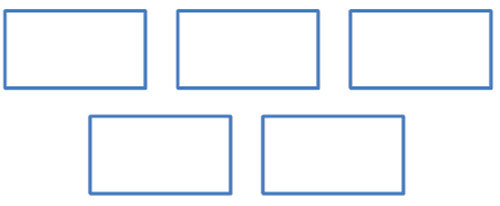
There are so many different ways to cut a rectangle into four equal parts.
Answers may vary from student to student. A sample answer is:
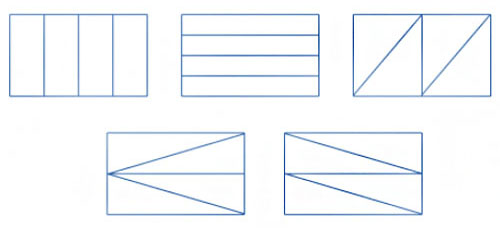
d) Colour half the number of shapes as shown here.
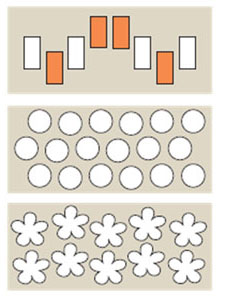
Do it by yourself. Answers may vary from student to student. There are 18 number of circles and 10 number of flowers. Colour any half of 18 that are 9 circles and half of 10 that are 5 flowers.
A sample answer is:
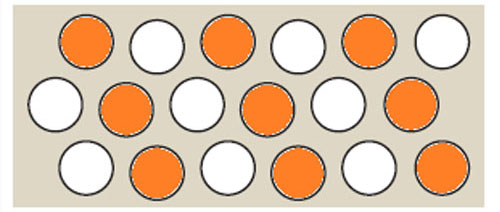

Shan poured 1 litre of milk into two bottles so that the first bottle holds 3/4 litre and the other holds 1/4 litre. Shade the level of milk in each bottle.
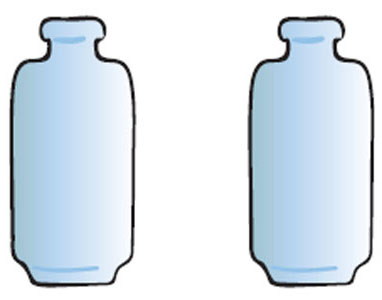
Divide each bottle into 4 parts. Shade 3 parts of the first bottle to show 3/4 level and 1 part of the second bottle to 1/4 litre.
The correct answer is:
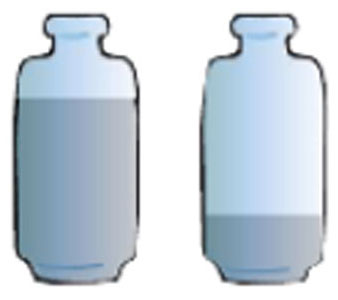
Ae) Colour 1/4 of these shapes.
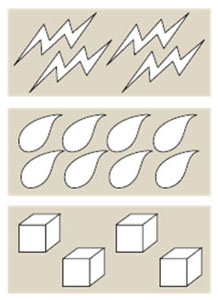
AIn the first shape there are 4 figures. Colour any 1 figure to get 1/4.
In the second shape there are 8 figures. Colour any 2 figure to get 1/4.
In the third shape there are 4 figures. Colour any 1 figure to get 1/4.
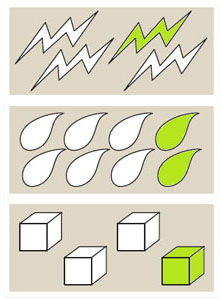
Keerthi is going for shopping. She has only Rs 20 with her. Can she buy all the things in her shopping list?
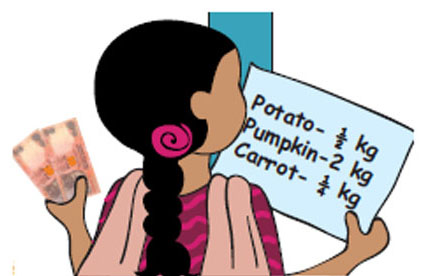
1 kg of potato is for Rs 12. Divide 12 by 2 to get the cost of 1/2 kg of potatoes.
12 ÷ 2 = 6
1 kg of pumpkin is for Rs 4. Multiply 2 by 4 to get the cost of 2 kg of pumpkin.
2 × 4 = 8
1 kg of carrot is for Rs 16. Divide 16 by 4 to get the cost of 1/4 kg of carrots.
16 ÷ 4 = 4
Add 6, 8, and 4 to get the total cost. 6 + 8 + 4 = 18 The total cost is Rs 18. Therefore, Keerthi can buy all the vegetables.
a) What part of the whole is coloured? Write below each shape.
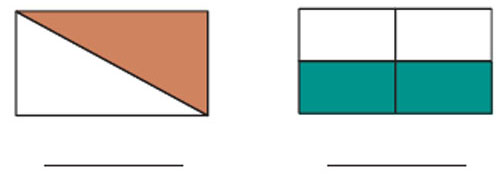
The first shape is divided into two equal parts out of which one part is coloured. Therefore, the coloured parts are 1/2
The second shape is divided into four equal parts out of which two parts are coloured. Therefore, the coloured parts are 2/4 or 1/2
The correct answer is:

h) This is a quarter of a picture. Can you complete it? How many more quarters will you draw to complete it? _____
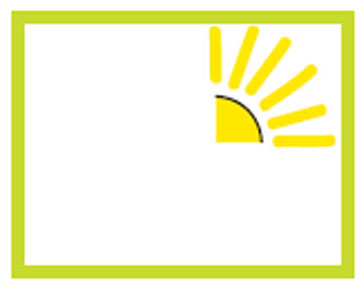
Draw three more quarters to complete the picture. The correct answer is:
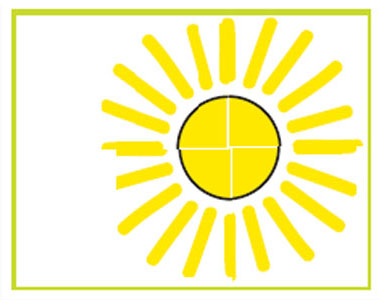
Balance the weight.
Choose from the weights above to make the two pans equal. In how many ways can you do it?
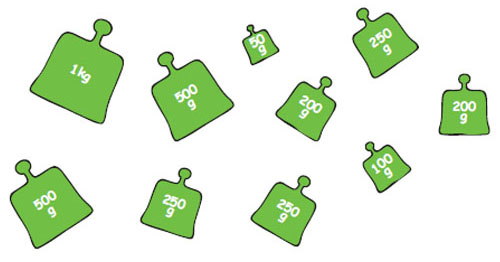

One of the pans contain 2 kg weight. In order to make the two pans equal same weight should be kept on the other pan, Use the fact that 1 kg = 1000 g and obtain the weight equal to 2 kg.
The answer may vary from student to student. Following are some sample ways:
1. 1 kg + 500 g + 500 g.
2. 500 g + 500 g + 250 g + 250 g + 200 g + 200 g +100 g.
3. 1 kg + 500 g + 250 g + 250 g.
4. 1 kg + 500 g + 250 g + 200 g + 50 g.
In how many different ways can you balance this weight of 3 4 kg?
1) ________
2) ________
3) ________
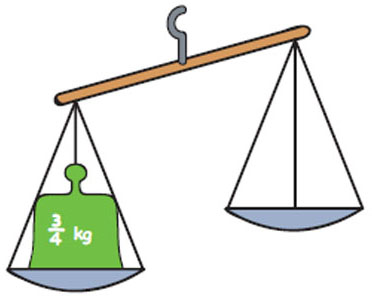
Step 1: We know that, 1 kg = 1000 g. Therefore, multiply 1000 by 3 to convert 3 kg to grams.
1000 × 3 = 3000
Step 2: Divide 3000 by 4 to convert 3/4 kg to gram.
3000 ÷ 4 = 750
Thus, 3/4 kg = 750 g.
Choose from the given weights to obtain an equivalent weight of 750 g. Answers may vary. A sample answer is:
1) 500 g + 250 g.
2) 250 g + 250 g + 200 g + 50 g.
3) 200 g + 200 g + 100 g + 250 g.
Kannan shaded some parts as shown. But his friend Mini says that it is wrong. Explain why it is wrong.
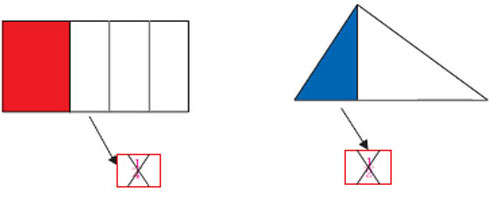
The given figure of rectangle shows that the rectangle is divided into four parts but each part of the rectangle is not equal. Therefore, the shaded part is not equal to 1/4.
It is observed from the given figure of triangle that the triangle is not divided into two equal halves. Therefore, the shaded part is not equal to 1/2.
Frequently Asked Questions
The NCERT solution for Class 4 Chapter 9: Halves And Quarters is important as it provides a structured approach to learning, ensuring that students develop a strong understanding of foundational concepts early in their academic journey. By mastering these basics, students can build confidence and readiness for tackling more difficult concepts in their further education.
Yes, the NCERT solution for Class 4 Chapter 9: Halves And Quarters is quite useful for students in preparing for their exams. The solutions are simple, clear, and concise allowing students to understand them better. They can solve the practice questions and exercises that allow them to get exam ready in no time.
You can get all the NCERT solutions for Class 4 Maths Chapter 9 from the official website of the Orchids International School. These solutions are tailored by subject matter experts and are very easy to understand.
Yes, students must practice all the questions provided in the NCERT solution for Class 4 Maths Chapter 9: Halves And Quarters as it will help them gain a comprehensive understanding of the concept, identify their weak areas, and strengthen their preparation.
Students can utilize the NCERT solution for Class 4 Maths Chapter 9 effectively by practicing the solutions regularly. Solve the exercises and practice questions given in the solution.

